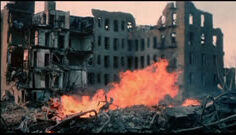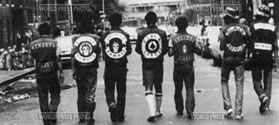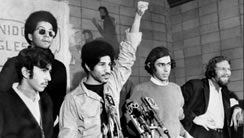Seminar: Latinos and the Urban Crisis



DESCRIPTION
How did the Urban Crisis of the 1960s, 70s and 80s affect Puerto Ricans, Cubans Dominicans and other Latinos in New York City, Hoboken, Jersey City, Newark, Perth Amboy, Paterson, Camden? How did the Urban Crisis in NJ differ from NYC? Was the urban crisis different for Latinos and African Americans? What responses did the urban crisis produce in Latino communities and governing elites? How did the anti-poverty programs affect Latinos? How did Latinos respond to all these challenges? Did Latino poverty originate in these crises or was it a result of migration and community characteristics?
The Urban Crisis has been defined by the exclusion of African Americans from full access to the benefits of capitalism and citizenship in urban contexts. In his classic study of Detroit Sugrue framed the emerging urban catastrophe that would launch Detroit into the headlines as a story rooted in this exclusion and worsened by the loss of jobs through deindustraalization and the city’s fiscal base through suburbanization. We will draw from these insights but link our study of the Crisis to additional themes that are more specifically grounded in the experience of New York City. Did the troubles of New York begin with deindustralization and suburbanization or were more deeply rooted in the political economy of poverty? How did Latino peoples-marked variably as racially non-white, white, in-between and black-experience the city’s worsening economic, fiscal and social problems? Between the 1960s and the 1980s the city became impoverished and hellish, with rampant arson, neglect, crime and joblessenss. How did Latinos respond to these crisis? Latinos (People of Puerto Rican, Cuban, Dominican descent) were both recent immigrant and long-standing residents of New York and did not necessarily share their responses to these problems. Were Latino Rights and political movements a response to these issues?
GOALS
This history research seminar will introduce you to the literature on the Urban Crisis in northeastern cities and relate the crisis to Black and Latino social and political movements. We will spend about eight sessions reviewing the literature and will have time to focus on individual research projects with newspapers, archives, interviews and other materials.
Student research projects will involve analyze census data, newspapers, government reports and other primary sources.
Students will travel to New York City or New Jersey libraries and archives at least five times during the semester. The last four weeks of the semester will have no assigned readings in order to allow time for this research work. I will find sources to cover all or most of your travel costs.
REQUIREMENTS
Your participation in this class constitutes an agreement between us. I expect you to come to all class sessions prepared and on time. I will provide you with feedback on your progress and present these materials to you in a coherent and organized manner. You will have approximately 100-150 pages of readings each week until after spring break when we will reduce the assigned reading so you can focus on your own research. You should expect to spend 7-10 hours a week working for this class. If you are not able to do this because of work or family obligations (or lack of interest) you should not take this course. Readings will be aroud 200 pp./week. Please notice that readings will change and will be posted as we go along the semester.
- Determination of Grade:
- Research Paper: 70%
- Research plans and reports: 15%
- Participation: 15%
- Participation:
- This is a seminar. Your participation in every session is obligatory. If you are absent more than once you will be asked to drop the course. Your participation in class activities, including attendance, will be an important component of your final grade. I will take attendance most of the time and more than two absences will reduce your class participation grade by half of a full grade for each absence.
- The short assignments that form part of the participation grade include occasional short response papers.They should be about one page long and need not be typewritten as long as your handwriting is legible. Occasionally we will break down into small discussion groups in order to tackle a question or designate students as discussion leaders for a session.
- Short assignments:
- We will have short assignments almost and student presentation of the readings every week. Short assignments will be graded with a plus, a check or a minus and will accumulate towards grades of A, B, or C (if they are all handed in). The usual grade will be a check which will indicate satisfactory completion (B). A minus indicates the absence of important components which will be specified. Lower grades will result from missing homework items. For most of the term you will focus on research for your research paper.
- Research paper:
- Your research paper will require analysis of relationships, not mere recitation of facts or stories. Because of the May due date late papers will not be accepted.
- There will be a writing tutor available for this course. I encourage you to take advantage of this valuable resource, its not only for students struggling with their writing…everyone can use a critic.
- Research plans and reports:
- You will have to submit various documents throughout the semester: a preliminary and final research proposals, research plan, reports on sources, and a log of work accomplished. See here for a detailed description of the research process and the documents required for the course.
- You are required to meet with me individually to discuss your strategy for the research project at least once before the weeks designated for individual meetings and then once a week during those two weeks.
- You will also have a due date (around April 20) for a full draft of your research paper and have an absolute final due date on May 5.
- The research paper will have to be based on your own research and discuss a very specific story drawn from the materials we will read in class and applied to a context you identify. The paper should have to be 20-25 pages and you will need to spend half of the semester doing in -depth research. We will aim to publish these papers.
Students are required to be familiar with departmental and University guidelines on plagiarism and the submission of written work. Please note that stringing together fragments of notes taken from the reading materials does note constitute paper-writing!
This course relies on our SAKAI site for access to readings, submission of work, communication, etc. The use of Sakai is not an optional component of the course but a vital parallel track to our class discussions and readings. You should check it once or twice a week and your email daily. The links from the web pages take you directly to the reading. If for some reason this does not work, you can access Sakai directly at sakai.rutgers.edu. Many of the readings are in PDF format. In order to read or print PDF format documents you must have Adobe’s Acrobat Reader installed. In order to read documents in MS-Word format you must have MS-Word or a word processor that can import files in MS-Word format (most of them can).
COURSE ORGANIZATION AND SCHEDULE
Week 1 Jan 22—Introduction: What Urban Crisis? A Crisis of the City, of Race or of Class?
- Sugrue. The Origins of the Urban Crisis: Race and Inequality in Postwar Detroit. Princeton. 1996.
- An interview with Sugrue
- Movie: Los Sures & Living Los Sures
- TV: The Get Down
Week 2 Jan 29—New York’s Urban Crises
- Readings:
- Fitch, Robert. The Assassination of New York. London. New York: Verso, 1993. Tables.
- Cowie, Jefferson, and Joseph Heathcott. Beyond the Ruins: The Meanings of Deindustrialization. Ithaca, NY; London: ILR Press, 2003. Chapters by Friedman and Gillete.
- Jonnes, Jill. South Bronx Rising: The Rise, Fall, and Resurrection of an American City. New York: Fordham University Press, 2002. Chaps. 13, 24.
- Cannato, Vincent J. The Ungovernable City: John Lindsay and His Struggle to Save New York. New York: Basic Books, 2002. Selected Pages.
- REITANO, JOANNE. Restless City: A Short History of New York from Colonial Times to the Present. London: Routledge, 2018. Chaps. 8-9.
- Gonzalez, Evelyn Diaz. The Bronx. New York: Columbia University Press, 2006. Chapter 7.
- Recommended:
- Mollenkopf and Castells. Dual City: Restructuring New York. New York: Russell Sage Foundation, 1991.
- Beauregard. Voices of Decline : The Postwar Fate of Us Cities. Oxford, UK ; Cambridge, Mass., USA: B. Blackwell, 1993.
- Morris. The Cost of Good Intentions : New York City and the Liberal Experiment, 1960-1975. New York: Norton, 1980.
- Movie: The Heart of Loisaida
- Examples of researchable questions
Week 3 Feb 5—Puerto Ricans, Cubans and Dominicans in NYC—Great Migrations and Class
- Whalen. “Colonialism, Citizenship, and the Making of the Puerto Rican Diaspora: An Introduction.” In The Puerto Rican Diaspora, Historical Persepectives.
- Haslip Viera. “The Evolution of the Latino Community in New York: Early Nineteenth Century to late Twentieth Century,” in Latinos in New York.
- Whalen. From Puerto Rico to Philadelphia. Chap. 5.
- Sanchez Korrol. “Building the New York-Puerto Rican Community: An Interpretation.” in Boricuas in Gotham: Puerto Ricans in the Making of Modern New York City.
- Huffnung Garskof. A Tale of Two Cities. Chap. 5.
- Recommended:
- Barber. Latino City: Immigration and Urban Crisis in Lawrence, Massachusetts, 1945-2000. 2017.
- Prieto, Yolanda. The Cubans of Union City: Immigrants and Exiles in a New Jersey Community. Philadelphia: Temple University Press, 2009.
Week 4 Feb 12—Work, Incomes and Poverty
- List of Research sites and sources
- Freeman. Working-Class New York : Life and Labor since World War II. New York: New Press: Distributed by W.W. Norton, 2000.
- Lauria-Santiago. A Better Life, manuscript. Chapter 8.
- Torres. Between Melting Pot and Mosaic: African Americans and Puerto Ricans in the New York Political Economy. Chap 3
- Bonilla and Ricardo Campos. “A Wealth of Poor: Puerto Ricans in the New Economic Order.” Daedalus, 110:2 (1981),133-176.
- David, Greg. Modern New York: The Life and Economics of a City. New York: Palgrave Macmillan, 2012.
- Sewell, Stacy Kinlock. “Left on the Bench: The New York Construction Trades and Racial Integration, 1960-1972.” New York History 83, no. 2 (2002): 203-34.
- Bonilla. “Manos que Sobran: Work, Migration and the Puerto Ricans in the 1990s”. In The Commuter Nation: Perspectives on Puerto Rican Migration, eds. Carlos Antonio Torre, Hugo Rodríguez Vecchini and William Burgos, 115–49.
Week 5 Feb 19—Housing, Communities and Ghettos
- Hoffnung-Garskof, Jesse. A Tale of Two Cities: Santo Domingo and New York After 1950. Princeton: Princeton University Press, 2008, Chapter 6.
- Snyder. Crossing Broadway, Chaps. 4 & 5.
- Patricia Cayo Sexton, Spanish Harlem. Chaps. 1-4.
- Abu-Lughod, Janet. From Urban Village to East Village : The Battle for New York’s Lower East Side. [in English] Oxford: Backwell, 1995.
- Gold, Roberta. When Tenants Claimed the City : The Struggle for Citizenship in New York Housing. [in English] Women in American History; Variation: Women in American History. Urbana, Chicago: Springfield, 2014.
- Soffer, Jonathan M. “Ed Koch and the Rebuilding of New York City.” [In English]. (2010).
Bloom, Nicholas Dagen. Public Housing That Worked : New York in the Twentieth Century. Philadelphia: University of Pennsylvania Press, 2008. - Thabit, Walter. How East New York Became a Ghetto. New York: New York University Press, 2003.
- Eisenberg, Martin Edward. “Being Left in East New York: Tensions between Race and Class in Community Organizing, 1954-1980.” Dissertation/Thesis, City University of New York, 1999.
- Arlene Davila. Barrios Dreams: Puerto Ricans, Latinos and the Neoliberal City. Chaps 1-2.
- Russell L. Sharman. The Tenants of East Harlem. Ch.3.
- Sanjek, Roger. The Future of Us All : Race and Neighborhood Politics in New York City. Ithaca: Cornell University Press, 1998.
- Jack Agueros, “Halfway to Dick and james,” in Hispanic New York, a sourcebook.
- Schwartz. The New York Approach: Robert Moses, Urban Liberals and Redevelopment in the Inner City, pgs. 159-169.
- Mele, Christopher. Selling the Lower East Side : Culture, Real Estate, and Resistance in New York City. [in English] Minneapolis: University of Minnesota Press, 2000.
- Oscar Lewis. La Vida. Ch. 33.
- Sanjek, Roger. The Future of Us All : Race and Neighborhood Politics in New York City. [in English] Ithaca: Cornell University Press, 1998.
- Lyford. The Airtight Cage. Ch. 3
- Christopher Mele, Selling the Lower East Side: Culture, Real Estate, and Resistance in New York City.
- Lorrin Thomas. Puerto Rican, Citizen. Chaps. 4
- Nathan Glazer and Daniel P. Moynihan, Beyond the Melting Pot, 86-136.
- Metzger, John T. “Rebuilding Harlem: Public Housing and Urban Renewal, 1920-1960.” Planning Perspectives [Great Britain] 9, no. 3 (1994): 255-96.
Week 6 Feb 25—Violence, Street Crime, Policing and Riots
- Thomas and Lauria Santiago, Rethinking the Struggle for Puerto Rican Rights, Manuscript. Chapter 5. Especially sections on Police and housing.
- Schneider, Cathy Lisa. Police Power and Race Riots: Urban Unrest in Paris and New York. University of Pennsylvania Press, 2014.
- Hayes, Christopher. “The Heart of the City: Civil Rights, Resistance and Police Reform in New York City, 1945—1966.” Ph.D., Rutgers The State University of New Jersey – New Brunswick, 2012.
- Johnson, Marilynn S. Street Justice : A History of Police Violence in New York City. Boston, Mass: Beacon Press, 2003.
- Darien, Andrew Todd. “Patrolling the Borders: Integration, Identity, and Patrol Work in the New York City Police Department, 1941—1975.” Ph.D., New York University, 2000.
- Schneider, Eric C. Vampires, Dragons, and Egyptian Kings : Youth Gangs in Postwar New York. Princeton, N.J.: Princeton University Press, 1999.
February 31 March 4—Spring Break: Work on your Research Proposals
Week 7 Mar 5—Wars Against Poverty
- Woodsworth, Michael. “The Forgotten Fight—Waging War on Poverty in New York City, 1945-1980.” Ph.D., Columbia University, 2013.
- Lee, Sonia Song-Ha. Building a Latino Civil Rights Movement : Puerto Ricans, African Americans, and the Pursuit of Racial Justice in New York City. Justice, Power, and Politics. Chapel Hill: The University of North Carolina Press, 2014.
- Moody, Kim. From Welfare State to Real Estate : Regime Change in New York City, 1974 to the Present. [in English] New York: New Press : Distributed by W.W. Norton & Co., 2007.
- Allegro, Linda. “Welfare Use and Political Response: Urban Narratives from First- and Second-Generation Puerto Ricans and Dominicans in New York City.” Centro: Journal of the Center for Puerto Rican Studies 17, no. 1 (2005): 220-41.
Week 8 March 19—Civil and Class Rights: Liberal and Radical Responses
- Muzio, Rose. Radical Imagination, Radical Humanity Puerto Rican Political Activism in New York. [in English] Albany: State University of New York Press, 2017.
- Biondi, Martha. To Stand and Fight : The Struggle for Civil Rights in Postwar New York City. Cambridge, Mass. ; London: Harvard University Press, Projected Date: 200604, 2006.
- Taylor, Clarence. Civil Rights in New York City : From World War II to the Giuliani Era. New York: Fordham University Press, 2011.
- Cannato, Vincent J. The Ungovernable City : John Lindsay and His Struggle to Save New York. 1st pbk. ed. New York: Basic Books, 2002.
- Jeffrey O. G. Ogbar, “Puerto Rican En Mi Corazón: The Young Lords, Black Power, and Puerto Rican Nationalism in the U.S. , 1966-1972,” Centro Journal XVIII, 001 (2006): 148-169.
- Young_Lords_Party—The_Puerto_Rican_Experience—Palante
- Louis Desipio, “The Pressures of Perpetual Promise: Latinos and Politics, 1960-2003,” in The Columbia History of Latinos in the United States Since 1960 ed. David G. Gutiérrez, 421-465.
- Miguel “Mickey” Melendez, We Took the Streets: Fighting for Latino Rights with the Young Lords, 189-198.
- Thomas, Lorrin. Puerto Rican Citizen: History and Political Identity in Twentieth-Century New York City. Historical Studies of Urban America. Chicago: University of Chicago Press, 2010.
- Jesse Huffnung Garskof. A Tale of Two Cities: Santo Domingo and New York after 1950. Chaps. 5-8.
- Ramona hernandez and silvio torres-Saillant. “Dominicans in New York: Men, Women and Prospects,” in Haslip Viera and Baver, eds. Latinos in new York.
- Movie: El Super
- Movie: Whose Barrio
Week 9 March 2—Racial Politics of the Crisis
- Podair, Jerald E. “The Strikes That Changed New York: Race, Culture, and Ocean Hill-Brownsville, 1960-1975.” Afro – Americans in New York Life and History 26, no. 1 (2002): 7.
- Binder, Frederick M. Reimers David M. All the Nations under Heaven : An Ethnic and Racial History of New York City. Columbia History of Urban Life. New York: Columbia University Press, 1995.
- Zeitz, Joshua. White Ethnic New York : Jews, Catholics, and the Shaping of Postwar Politics. Chapel Hill: University of North Carolina Press, 2007.
- Podair, Jerald E. The Strike That Changed New York : Blacks, Whites, and the Ocean Hill-Brownsville Crisis. New Haven, Conn. [u.a.]: Yale Univ. Press, 2002.
- Taylor, Clarence, and Milton A. Galamison. Knocking at Our Own Door : Milton A. Galamison and the Struggle to Integrate New York City Schools. [in English] Lanham, Md.: Lexington Books, 2001.
- Sleeper, Jim. The Closest of Strangers: Liberalism and the Politics of Race in New York. New York: W.W. Norton, 1990.
- Sugrue, Thomas J. “Crabgrass-Roots Politics: Race, Rights, and the Reaction against Liberalism in the Urban North, 1940-1964.” The Journal of American History 82, no. 2 (1995): 551-78.
- Movie: Saturday Night Fever
- Movie: West Side Story
Week 10 April 2—Burning Down the House and the City’s Fiscal Crisis
- Wunsch, James L. “From Burning to Building: The Revival of the South Bronx 1970-1999.” Bronx County Historical Society Journal 38, no. 1 (03// 2001): 4-22.
- Flood, Joe. The Fires: How a Computer Formula Burned Down New York City—and Determined the Future of American Cities. New York: Riverhead Books, 2010. TBA
Week 11–April 9-Individual Meetings
Week 12–April 16-Individual Meetings
Week 13–April 23—In-class Research reports
Week 14-April 30—In-class Research reports